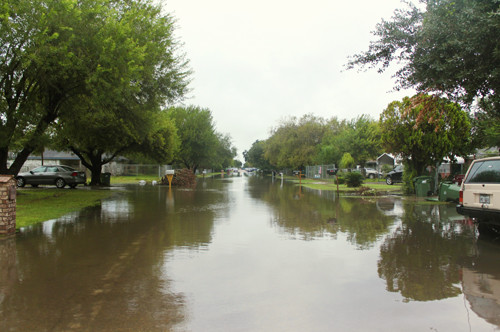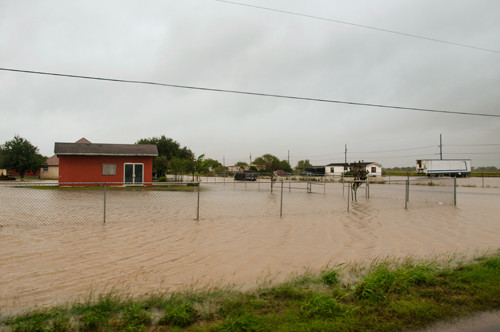![ForecastRay1102_web[1]](https://www.utrgvrider.com/wp-content/uploads/2015/09/ForecastRay1102_web1.jpg)
A flooded Raymondville neighborhood affected by severe rain that hit the Rio Grande Valley. Angela Cantu/The Rider
Ena Capucion
ARTS AND ENTERTAINMENT EDITOR
Typhoon Haiyan had about 195 mph winds when it hit the Philippines Nov. 8, 2013. After five weeks, the death toll rose to over 6,000 and about 1,800 people were still missing. When Hurricane Patricia made landfall in southwestern Mexico Oct. 23, the 165 mph storm dissipated into a tropical storm with 35 mph winds–leaving the death toll at zero.
During the formation of Patricia, the hurricane’s winds rapidly intensified–from 85 to 200 mph winds within a 24-hour window in the early morning of Oct. 22. Tim Smith, chief meteorologist for KRGV-TV Channel 5, said the mountains in Mexico played a big part in decreasing the intensity of what was once a Category 5 hurricane.
“It is difficult for any storm to maintain such severe conditions for an extended period of time,” the Batesville, Ind. native said. “Likely, even without the mountains, it would have lost at least some of its strength. Once the center of a storm moves over land, it moves away from the warm ocean, which is the fuel for a tropical system. So, all storms weaken when they move over land. It’s just that the mountains made it happen much more quickly. The mountains destroy the circulation of a hurricane. The taller the mountains, the more the circulation gets interrupted. The mountains in Mexico are quite tall and led to the demise of the storm.”
UTRGV computer science junior Carlos Braña is a native of Ciudad Victoria, Tamaulipas, Mexico, and experienced Hurricane Alex in 2010. He filmed the aftermath of Alex and documented heavy floods and fallen billboards–however, nothing directly affecting the community. With Hurricane Patricia, Braña understood that the intensity was much worse than Hurricane Alex, but was assured of his safety.
“Usually [the] poor are the only ones affected by hurricanes,” the 22-year-old said. “People that belong to the lower middle class and up, all have houses made out of concrete. Almost always the damage is reduced to only windows broken and maybe house flooding.”
According to the Los Angeles Times, Mexico learned to prepare for the worst. While officials kept watch of the formation of Patricia, warnings were displaced on the radio as well as television broadcasts across the region. For those without access, government pickup trucks with speakers made their way around.
Other precautions included the dispatch of about 3,000 soldiers and 800 federal police officers to areas that were in line with Patricia’s route as well as 1,200 shelters to accommodate 240,000 people.
In the aftermath, Patricia affected several coastal states that include Colima, Jalisco, Michoacan and Nayarit. Mexican President Enrique Peña Nieto said, about 3,500 homes were damaged and about 200,000 people lost power–however, nearly half of them regained electricity quickly.
Not only did Patricia affect Mexico, but the hurricane also brought heavy rains to the Rio Grande Valley, mainly hitting Weslaco and Donna.
Between 1 and 2 p.m. Oct. 24, UTRGV theatre junior Kristin Valdez was driving home from a gathering with friends until her car engine became submerged in water on Salinas Boulevard in Donna–with about three to five other vehicles also stranded.
“We weren’t prepared. … All we thought was [that] it was going to rain a bit, but not on the scale that it did,” the
Donna native said. “Being stuck in the middle of the road, with the rain pouring down and a car that’s dead and a phone on 10 percent, I was honestly very scared and slightly panicked since I was alone.”With the help of the tall mountains that reside in Mexico and the two strangers that assisted Valdez, Patricia didn’t do all the damage it could have done.








